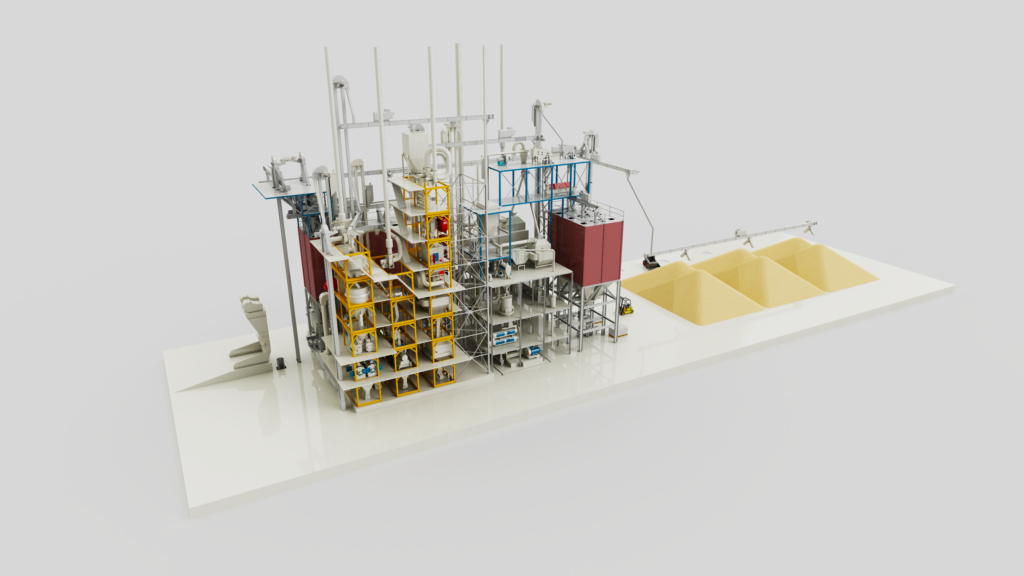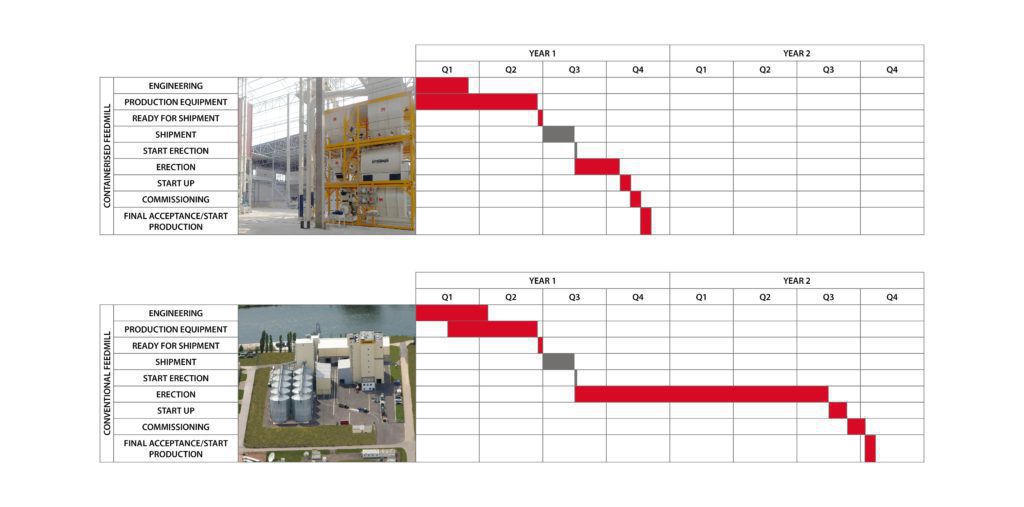Blog : Modular aquafeed installations
Organisation of the United Nations reports that the majority of aquaculture production small comes from developing regions in the world. Building an aquafeed mill in these regions could be challenging as mechanical and electrical installaton services are not always easily available. Containerized or partially containerized feed mills could offer a perfect solution for this challenge.
Modernday feed mills could be designed and built as either a conventional or containerized feed mill. A conventional feed mill design requires the main building or superstructure to accommodate and support all the equipment required by the process.This design approach suits very large feed mills well. Containerized feed plants on the other hand are designed in a modular way, and normally contain all the plant equipment, electrical installation and process control equipment, assembled and installed into support structures the size of one or multiple standard 20‐foot shipping containers.
These modules or containers are laid out in a main building or superstructure that becomes a “shell” protecting the plant from the elements without direct support of the equipment.
Containerized and partially containerized feed plants as shown in Fig. 1, suits the requirements and scale of Fish Feed manufacturing in especially developing and remote areas very well.
Process and engineering design and functionality
Whether building a conventional or containerized aquatic feed plant, it is and should be designed to fulfil a specific feed manufacturing function successfully.
This applies for extruded and pelleted Fish feed plants. At the same time, care should be taken to ensure the engineering design of the entire plant is done the right way. A containerized plant ensures this responsibility is left to the supplier, and leaves the processor with more me for marketing and operational business development. A containerized plant also takes away the burden of ensuring that all equipment in theplant is a good functional match and that everything goes together well at the me of Installation.
Mechanical and electrical installation
Sourcing good quality equipment from one or more suppliers is one thing. Making sure that all these items are installed and assembled in a way that optimizes plant performance while minimizing capital investment and ongoing operational cost, is quite another. Mechanical and electrical installation expertise are in many cases difficult to obtain in some regions where aquaculture is practised. This may leave the customer with a massive challenge installing all equipment in a professional and
timely manner. In a well-designed containerized plant, all equipment, conveyors, electrical installation and process control devices are installed and assembled at the point of manufacture before shipping takes place.
Tested at point of manufacture
Days and even weeks could go to waste as customers are trying to get conventional plants and equipment tested and finetuned before start up can take place. Substandard electrical installation and process control systems normally contribute most to this situation. All of these are avoided with containerized plants as all mechanical, electrical and process control installations are tested at the point of manufacture.
Reduced installation time on‐site
On-site preparations such as foundations take place while the containerized plant is being manufactured.Once the containerized plant arrives on‐site installation can normally happen in record time. It is not uncommon to cut installation time by almost 50% in comparison to conventional plant(figure 2). Unnecessary assembly and installation time and problems getting support structures, transitions, ducting, cabling and other mechanical and electrical materials and services concluded, may lead to hidden costs that are difficult to account for beforehand. This additional cost could easily equal and even exceed the cost of mechanical and electrical assembly and installation by the supplier of the containerized or parally containerized aquafeed plant.
No support structures required
One of the most important features of a containerized plant is that no support structures are required. The container sized structures that already contains the installed equipment, also serve as support structures for the entire plant. Plant layout could be horizontal and vertical; completely or partially containerized, while the container modules are designed to be structurally sound.
Lower building costs
A containerized or partially containerized plant could be housed inside a basic “shed‐like” building. Such a building only needs to be designed carrying its own weight as the containers installed inside the building carry the load of all plant and equipment. This reduce building cost and installation me substantially.
Lower freight and handling cost
No special crang and shipping materials are required as the individual container modules are simply cladded with protective sheets meeting international shipping requirements and standards. Once on‐site these sheets are simple removed before installation of the containers modules.
Organisation of the United Nations reports that the majority of aquaculture production small comes from developing regions in the world. Building an aquafeed mill in these regions could be challenging as mechanical and electrical installaton services are not always easily available. Containerized or partially containerized feed mills could offer a perfect solution for this challenge.
Containerized plants for any application
Any aquatic feed process could be designed as a containerized or partially containerized plant. The type and range of Fish feeds to be produced, as well as the complexity of the process and size of the plant, will determine whether it is designed as a Containerized or Partially Containerized Plant. Containerized aquafeed plants could range from small to 20 ton/h and more.
You can send an e-mail to mkp@ottevanger.com.
Read more:



